The area now known as Los Angeles had its beginnings in 1769 when Gaspar de Portola led an exploratory expedition of more than 60 persons through the region. In September 1771, Father Junipero Serra and a group of Spaniards founded the San Gabriel Mission as the center of the first community in an area inhabited by Gabrielino Indians. On September 4, 1781, another community was established by the Pobladores in the area discovered by Portola, and over time the area became known as the Ciudad de Los Angeles or “City of Angels.” California continued under Spanish rule until Mexico assumed jurisdiction in 1822. Following a two-year period of hostilities with Mexico that began in 1846, the U.S. assumed control of the area. In 1848, the Treaty of Guadalupe Hidalgo made California a United States Territory. Several months before California was admitted to the Union, the County of Los Angeles was established on February 18, 1850, as one of the 27 original counties. On April 4, 1850, the City of Los Angeles became incorporated, and in 1851 the County of Los Angeles was divided into six townships.
As the region’s population kept growing, Los Angeles experienced a boom time that began in the mid-1880s and continued well into the next century.
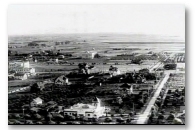 In 1886-87, Los Angeles’ first public high school opened. The following year, the Los Angeles Chamber of Commerce was established at a meeting of the city's principal boosters, and in 1889 the California legislature created Orange County from the southern portion of Los Angeles. Also in 1889, the first college football game in Los Angeles was played between USC and Saint Vincent's College (Loyola), with the first Tournament of Roses Parade held in Pasadena the following year. When President Benjamin Harrison visited Pasadena in 1891, he became the first U.S. President to visit the Los Angeles area.
In 1886-87, Los Angeles’ first public high school opened. The following year, the Los Angeles Chamber of Commerce was established at a meeting of the city's principal boosters, and in 1889 the California legislature created Orange County from the southern portion of Los Angeles. Also in 1889, the first college football game in Los Angeles was played between USC and Saint Vincent's College (Loyola), with the first Tournament of Roses Parade held in Pasadena the following year. When President Benjamin Harrison visited Pasadena in 1891, he became the first U.S. President to visit the Los Angeles area.
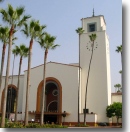 In 1895, the heavily traveled Los Angeles thoroughfare was named Wilshire Boulevard, and two years later, J. Philip Erie drove the first automobile through the streets of Los Angeles. The vehicle he drove was built by S.D. Sturgis in a downtown L.A. shop. The increasing popularity of automobiles lead to the establishment of the Automobile Club of Southern California in 1900. The following year, President William McKinley became the first U.S. President to visit the City of Los Angeles. On New Years Day 1902, the first Tournament of Roses football game was played, and Michigan beat Sanford 49-0. In 1903, William Randolph Hearst established the Los Angeles Examiner, which later joined the Herald Express to become, in 1962, the Los Angeles Herald-Examiner.
In 1895, the heavily traveled Los Angeles thoroughfare was named Wilshire Boulevard, and two years later, J. Philip Erie drove the first automobile through the streets of Los Angeles. The vehicle he drove was built by S.D. Sturgis in a downtown L.A. shop. The increasing popularity of automobiles lead to the establishment of the Automobile Club of Southern California in 1900. The following year, President William McKinley became the first U.S. President to visit the City of Los Angeles. On New Years Day 1902, the first Tournament of Roses football game was played, and Michigan beat Sanford 49-0. In 1903, William Randolph Hearst established the Los Angeles Examiner, which later joined the Herald Express to become, in 1962, the Los Angeles Herald-Examiner.
 The American film industry had its start in the Northeast and it was burgeoning; but Thomas Edison’s Motion Picture Patents Company (Edison Trust) controlled the business with heavy fees and restrictions on filmmakers. It is no wonder that the sunny weather conditions of Southern California lured independent filmmakers as far away as possible from Edison’s New Jersey base. In 1906, the first motion picture studio was established in Los Angeles, and later that year, the first movie theater opened. In 1907, filmmaker Francis Boggs finished his motion picture The Count of Monte Cristo (1907) in Los Angeles. Boggs' Chicago-based employer instructed him to set up a permanent film operation in Los Angeles, and the following year Boggs completed In the Sultan's Power (1908), the first motion picture made entirely in Los Angeles.
The American film industry had its start in the Northeast and it was burgeoning; but Thomas Edison’s Motion Picture Patents Company (Edison Trust) controlled the business with heavy fees and restrictions on filmmakers. It is no wonder that the sunny weather conditions of Southern California lured independent filmmakers as far away as possible from Edison’s New Jersey base. In 1906, the first motion picture studio was established in Los Angeles, and later that year, the first movie theater opened. In 1907, filmmaker Francis Boggs finished his motion picture The Count of Monte Cristo (1907) in Los Angeles. Boggs' Chicago-based employer instructed him to set up a permanent film operation in Los Angeles, and the following year Boggs completed In the Sultan's Power (1908), the first motion picture made entirely in Los Angeles.
 By 1910, German-born Carl Laemmle had changed the face of the industry by creating the star system, much to the chagrin of other movie companies who chose to keep their stars anonymous. The publicity stunt involving the faked death of Biograph girl Florence Lawrence shook the very core of the film industry and forced studios to recognize and compensate actors for their roles. In 1912, Laemmle merged his Independent Motion Picture Company with Bison 101, Nestor Films, the U.S. production facilities of French studio Eclair, and several other film companies to create Universal Film Manufacturing Company. The following year, Cecil B. DeMille telegrammed his New York partners and requested authority to rent a barn in Hollywood to film the motion picture The Squaw Man (1914).
By 1910, German-born Carl Laemmle had changed the face of the industry by creating the star system, much to the chagrin of other movie companies who chose to keep their stars anonymous. The publicity stunt involving the faked death of Biograph girl Florence Lawrence shook the very core of the film industry and forced studios to recognize and compensate actors for their roles. In 1912, Laemmle merged his Independent Motion Picture Company with Bison 101, Nestor Films, the U.S. production facilities of French studio Eclair, and several other film companies to create Universal Film Manufacturing Company. The following year, Cecil B. DeMille telegrammed his New York partners and requested authority to rent a barn in Hollywood to film the motion picture The Squaw Man (1914).
With the success of D.W. Griffith's The Birth of a Nation (1914), Los Angeles became the center of the motion picture industry. On March 15, 1915, Carl Laemmle opened Universal Studios on a 230-acre chicken ranch on the outskirts of Los Angeles.
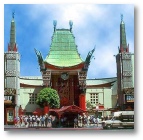 It was later called Universal City. Laemmle regularly invited visitors to tour the facilities and observe the behind-the-scenes magic of moviemaking. The mid-1910s to early 1920s was a time of turmoil and power struggles in the industry. Movie production companies were bought and sold almost daily, and stars moved to rival studios. Under-the-table dealings became the norm as film execs vied to make theirs the number one studio. Out of the chaos, several significant new studios emerged. Some were created by mergers; some were formed by individuals who had worked at other studios. In 1916, Adolph Zukor's Famous Players and Jesse Lasky's Feature Players merged to form the Famous Players-Lasky. Charlie Chaplin, while still making films for other studios, built his own movie studio in Los Angeles in 1917 where he filmed all of his classic “Little Tramp” silent films. During this time, Adolph Zukor became a controlling force in the film industry, and required exhibitors to show only his films. He would offer them block-booking, which included a block of 104 films each year. Not only did exhibitors have no idea what films they were acquiring, they were charged more money if they made their own selections. Zukor's power-hungry practice created so much resentment among the leading movie exhibitors that in 1917, Thomas L. Tally, a Los Angeles theater owner, organized local area exhibitors to buy and distribute their own films. Along with West Virginia theater owner, John D. Williams, Tally formed the First National Exhibitors Circuit. First National grew from 100 to 600 theaters nationwide and produced films until 1935.
It was later called Universal City. Laemmle regularly invited visitors to tour the facilities and observe the behind-the-scenes magic of moviemaking. The mid-1910s to early 1920s was a time of turmoil and power struggles in the industry. Movie production companies were bought and sold almost daily, and stars moved to rival studios. Under-the-table dealings became the norm as film execs vied to make theirs the number one studio. Out of the chaos, several significant new studios emerged. Some were created by mergers; some were formed by individuals who had worked at other studios. In 1916, Adolph Zukor's Famous Players and Jesse Lasky's Feature Players merged to form the Famous Players-Lasky. Charlie Chaplin, while still making films for other studios, built his own movie studio in Los Angeles in 1917 where he filmed all of his classic “Little Tramp” silent films. During this time, Adolph Zukor became a controlling force in the film industry, and required exhibitors to show only his films. He would offer them block-booking, which included a block of 104 films each year. Not only did exhibitors have no idea what films they were acquiring, they were charged more money if they made their own selections. Zukor's power-hungry practice created so much resentment among the leading movie exhibitors that in 1917, Thomas L. Tally, a Los Angeles theater owner, organized local area exhibitors to buy and distribute their own films. Along with West Virginia theater owner, John D. Williams, Tally formed the First National Exhibitors Circuit. First National grew from 100 to 600 theaters nationwide and produced films until 1935.
Several events in the latter half of the 1920s were especially notable in the growth of Los Angeles and its film industry. In 1926, the El Capitan Theater opened, followed by the opening of Grauman's Chinese Theatre and the Hollywood Roosevelt Hotel in 1927.
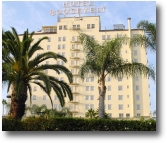 The Academy of Arts & Sciences was also organized in 1927, with the first Academy Awards Ceremony held two years later at the Hollywood Roosevelt Hotel. Warner Brothers’ 1927 talkie The Jazz Singer ended the silent era, and in 1928 Walt Disney released the first Mickey Mouse cartoon. Beginning in the mid-1920s and continuing to the mid-1930s, the movie industry experienced a shift in power. Although there were a number of independent filmmakers, most of the major films were produced by eight studios. The industry referred to these as the “Big Five” and the “Little Three.” The “Big Five” included MGM, Paramount Pictures, RKO Pictures, Warner Brothers Pictures and 20th Century Fox. The “Little Three” were Columbia Pictures, United Artists and Universal Pictures. Despite the prominence of these eight studios, however, significant contributions were also made by Walt Disney Company, Monogram Picture Corporation, Republic Pictures, Selznick International and American International Pictures.
The Academy of Arts & Sciences was also organized in 1927, with the first Academy Awards Ceremony held two years later at the Hollywood Roosevelt Hotel. Warner Brothers’ 1927 talkie The Jazz Singer ended the silent era, and in 1928 Walt Disney released the first Mickey Mouse cartoon. Beginning in the mid-1920s and continuing to the mid-1930s, the movie industry experienced a shift in power. Although there were a number of independent filmmakers, most of the major films were produced by eight studios. The industry referred to these as the “Big Five” and the “Little Three.” The “Big Five” included MGM, Paramount Pictures, RKO Pictures, Warner Brothers Pictures and 20th Century Fox. The “Little Three” were Columbia Pictures, United Artists and Universal Pictures. Despite the prominence of these eight studios, however, significant contributions were also made by Walt Disney Company, Monogram Picture Corporation, Republic Pictures, Selznick International and American International Pictures.
Today, Hollywood is a trendy and all encompassing term for the legendary Los Angeles dream machine. The name evokes visions of glamour, fame, intense drama, screwball and slapstick comedy, epic grandeur, and wondrous adventure.
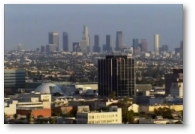 Hollywood has been the setting for hundreds of films, and over the years, many area residences, stores, restaurants, hotels, banks, office buildings, schools, avenues and streets have served as settings on both the big screen and television. Some of the more famous and recognizable edifices and locales include those seen in The Music Box (1932), King Kong (1933), Going My Way (1944), It's a Wonderful Life (1946), Sunset Boulevard (1950), War of the Worlds (1953), Rebel Without a Cause (1955), Inside Daisy Clover (1965), Funny Girl (1968), Conquest of the Planet of the Apes (1972), The Sting (1973), Chinatown (1974), Grease (1978), Halloween (1978), Blade Runner (1982), E.T. The Extra-Terrestrial (1982), Beverly Hills Cop (1984), The Terminator (1984), Back to the Future (1985), Down and Out in Beverly Hills (1986), Ruthless People (1986), Lethal Weapon (1987), Die Hard (1988), Pretty Woman (1990), Father of the Bride (1991), The Rocketeer (1991), Scenes From a Mall (1991), In the Line of Fire (1993), Jurassic Park (1993), Forrest Gump (1994), Pulp Fiction (1994), Heat (1995), L.A. Confidential (1997) and The X Files (2000). These films collectively represent a diverse cross-section of entertainment escapism. Many of the same locales seen on the big screen have also appeared on television. A few of the more well-known of these programs include Adventures of Superman, Perry Mason, Bonanza, The Beverly Hillbillies, Dragnet, Kojak, The Incredible Hulk, Knots Landing, Falcon Crest, Hill Street Blues, Cagney & Lacey, Knight Rider, Remington Steele, L.A. Law and Melrose Place.
Hollywood has been the setting for hundreds of films, and over the years, many area residences, stores, restaurants, hotels, banks, office buildings, schools, avenues and streets have served as settings on both the big screen and television. Some of the more famous and recognizable edifices and locales include those seen in The Music Box (1932), King Kong (1933), Going My Way (1944), It's a Wonderful Life (1946), Sunset Boulevard (1950), War of the Worlds (1953), Rebel Without a Cause (1955), Inside Daisy Clover (1965), Funny Girl (1968), Conquest of the Planet of the Apes (1972), The Sting (1973), Chinatown (1974), Grease (1978), Halloween (1978), Blade Runner (1982), E.T. The Extra-Terrestrial (1982), Beverly Hills Cop (1984), The Terminator (1984), Back to the Future (1985), Down and Out in Beverly Hills (1986), Ruthless People (1986), Lethal Weapon (1987), Die Hard (1988), Pretty Woman (1990), Father of the Bride (1991), The Rocketeer (1991), Scenes From a Mall (1991), In the Line of Fire (1993), Jurassic Park (1993), Forrest Gump (1994), Pulp Fiction (1994), Heat (1995), L.A. Confidential (1997) and The X Files (2000). These films collectively represent a diverse cross-section of entertainment escapism. Many of the same locales seen on the big screen have also appeared on television. A few of the more well-known of these programs include Adventures of Superman, Perry Mason, Bonanza, The Beverly Hillbillies, Dragnet, Kojak, The Incredible Hulk, Knots Landing, Falcon Crest, Hill Street Blues, Cagney & Lacey, Knight Rider, Remington Steele, L.A. Law and Melrose Place.
Hollywood is driven by the tremendous entertainment energy of Los Angeles. California remains the leading supplier of entertainment to the world, with Los Angeles County producing the vast majority of the state's output. Although filmmaking in the United States had its roots in West Orange, New Jersey, the dream machine was perfected in Los Angeles, and the business continues to boom. In the realm of moviemaking, when you visit the Los Angeles area you truly are walking on hallowed ground.